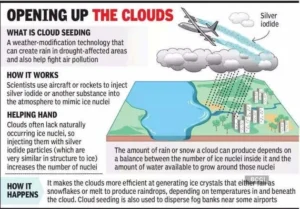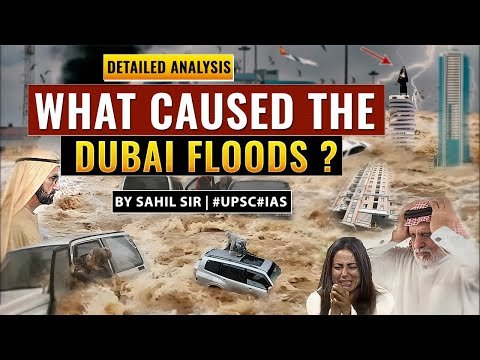Dubai Rainfall, Climate Change and Cloud Seeding | UPSC
Introduction
- Dubai has been hit by record floods over the past 24 hours, sparking misleading speculation about cloud seeding.
- So how unusual was the rainfall and what were the reasons behind the extreme downpours?
Causes of exceptional rainfall in Dubai
- Experts and officials have debunked the speculations that cloud seeding caused the rainfall.
- The exceptional rainfall was likely due to a local storm (a low pressure weather system) that was exacerbated by climate change.
-
- When the wind speeds reach 63 kph it is classified a ‘tropical storm. ‘ Above 119 kph, they are categorized as either a hurricane, typhoon or tropical cyclone.
-
- This storm transported abundant tropical moisture from near the equator and released it heavily over the region.
- Huge tropical storms like this “are not rare events for the Middle East. In the past, nearly 100 such events have been observed over the southern Arabian Peninsula from 2000 to 2020, with most in March and April.
Role of the climate change in causing the torrential rainfall in Dubai
- Climate scientists say that rising global temperatures, caused by human-led climate change, is leading to more extreme weather events around the world, including intense rainfall.
- Global warming has resulted in “extraordinarily” warm water in the seas around Dubai, where there is also very warm air above.
- This increases both potential evaporation rates and the capacity of the atmosphere to hold that water, allowing bigger dumps of rainfall such as what we have just seen in Dubai.
-
- Warmer air can hold more moisture – about 7% extra for every degree Celsius – which can in turn increase the intensity of rain.
-
What is cloud seeding and did it play a role?

- Cloud seeding involves manipulating existing clouds to help produce more rain or snow.
- Clouds are made up of tiny water droplets or ice crystals that form when water vapor in the atmosphere cools and condenses around a tiny particle of dust or salt floating in the atmosphere.
-
- Without these particles, known as condensation or ice nuclei and provide a base for moisture to attach to, raindrops or snowflakes cannot form and precipitation will not occur.
-
- Cloud seeding uses planes and ground-based cannons to shoot particles into clouds making more condensation nuclei, attracting moisture.
- Once enough droplets merge, they become heavy and fall to Earth as rain or snow.
- Note: The cloud seeding method can’t create water from a clear sky – particles must be shot into a cloud that already holds moisture to get it to fall, or to fall more than it otherwise would naturally. Cloud seeding is generally deployed when conditions of wind, moisture and dust are insufficient to lead to rain.
Substances used for seeding clouds
- Many substances have been used, but solid carbon dioxide (dry ice) and silver iodide have been the most effective in the formation of ice crystals.
-
- In clouds at temperatures above freezing, calcium chloride particles provide the condensation nuclei around which raindrops form.
-
- Silver iodide exists naturally in the environment at low concentrations, and is not known to be harmful to humans or wildlife.
Benefits of Cloud Seeding
- Cloud seeding is used all over the world as a method for enhancing winter snowfall and increasing mountain snowpack, supplementing the natural water supply available to communities of the surrounding area.
- China also used it during the 2008 Olympics in Beijing with the goal of keeping the skies clear.
References:
- https://www.bbc.com/news/science-environment-68839043
- https://www.dri.edu/cloud-seeding-program/what-is-cloud-seeding/
- https://www.britannica.com/science/cloud-seeding
- https://www.aljazeera.com/news/2024/4/18/was-cloud-seeding-responsible-for-the-floodings-in-dubai#:~:text=Flooding%20in%20Dubai%20after%20a%20year’s%20worth%20of%20rain%20falls%20in%20hours&text=Speculation%20was%20rife%20on%20social,likely%20caused%20by%20climate%20change.
- https://economictimes.indiatimes.com/news/india/indian-scientists-get-breakthrough-in-cloud-seeding-maharashtras-solapur-gets-18-more-rainfall/articleshow/104717588.cms?from=mdr
Practice Questions for UPSC Prelims:
Q. Which of the following statements best defines cloud seeding?
a) It is a process of creating clouds artificially in the atmosphere to induce rainfall.
b) It involves manipulating existing clouds to help produce more rain or snow.
c) It is the method of creating clouds from a clear sky to cause human-induced rainfall.
d) It involves redirecting clouds to certain regions to cause rainfall or snowfall.
Answer: b
Explanation:
- Cloud seeding involves manipulating existing clouds to help produce more rain or snow.
- Clouds are made up of tiny water droplets or ice crystals that form when water vapor in the atmosphere cools and condenses around a tiny particle of dust or salt floating in the atmosphere.
-
- Without these particles, known as condensation or ice nuclei and provide a base for moisture to attach to, raindrops or snowflakes cannot form and precipitation will not occur.
-
- Cloud seeding uses planes and ground-based cannons to shoot particles into clouds making more condensation nuclei, attracting moisture.
- Once enough droplets merge, they become heavy and fall to Earth as rain or snow.
- Note: The cloud seeding method can’t create water from a clear sky – particles must be shot into a cloud that already holds moisture to get it to fall, or to fall more than it otherwise would naturally. Cloud seeding is generally deployed when conditions of wind, moisture and dust are insufficient to lead to rain.
- Many substances have been used, but solid carbon dioxide (dry ice) and silver iodide have been the most effective in the formation of ice crystals.
Therefore, option (b) is the correct answer.
Relevance: Dubai has been hit by record floods over the past 24 hours, sparking misleading speculation about cloud seeding.
Subject: Current Affairs | Geography
Level of Difficulty: Moderate | Factual
Answer Writing Practice for UPSC Mains:
Topic: Important Geophysical Phenomena (GS Mains Paper 1)
Q. Rising global temperature, caused by human-led climate change, is leading to more extreme weather events around the world, including intense rainfall. Substantiate with some recent examples. (Answer in 250 words)

